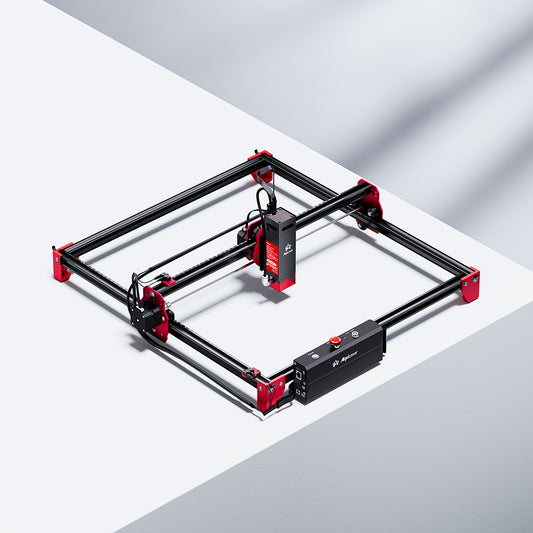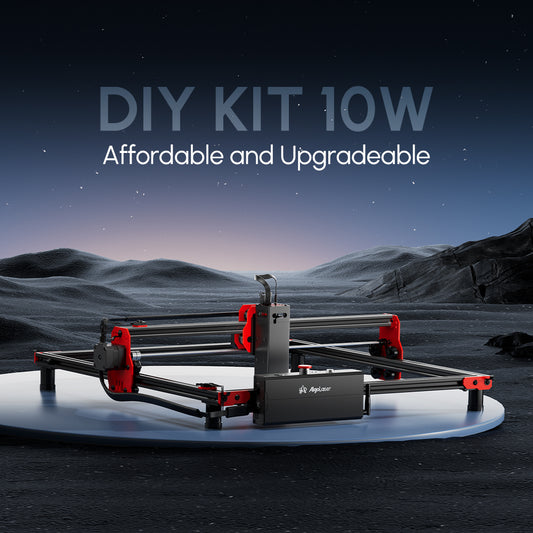How to Operate the Alpha MK2 With a USB Stick
Laser engravers have revolutionized the world of art, design, and manufacturing, offering precision, speed, and versatility. The AlgoLaser Alpha MK2 stands out as a cutting-edge diode laser engraving machine designed to cater to both hobbyists and professionals. This guide will walk you through the entire process of using the AlgoLaser Alpha MK2, from connecting a USB drive to executing intricate engraving and cutting tasks. By the end of this article, you'll have a comprehensive understanding of how to maximize the potential of this powerful machine.
1. Introduction to AlgoLaser Alpha MK2
The AlgoLaser Alpha MK2 is a state-of-the-art diode laser engraving and cutting machine. Renowned for its precision and efficiency, it caters to a diverse range of applications, from creating detailed artworks to cutting materials with intricate designs. The Alpha MK2 is designed for ease of use, featuring an intuitive interface powered by AlgoOS and a robust graphics processing engine, Algo Graphics Engine.
2. Key Features of AlgoLaser Alpha MK2
High Precision Diode Laser: The Alpha MK2 is equipped with a high-precision diode laser, capable of engraving and cutting various materials with exceptional accuracy.
User-Friendly Interface: AlgoOS, the machine's operating system, offers a seamless user experience, simplifying the process of selecting and executing tasks.
Algo Graphics Engine: This powerful graphics processing engine ensures smooth and detailed rendering of images and designs.
Versatility: The Alpha MK2 supports Original Image Engraving and Original SVG Cutting, allowing users to work with different file types and achieve professional results.
3. Understanding the AlgoOS and Algo Graphics Engine
AlgoOS is the proprietary operating system designed specifically for AlgoLaser products. It provides a streamlined interface for managing engraving and cutting tasks. The Algo Graphics Engine enhances the processing capabilities of the machine, ensuring that even the most complex designs are rendered with precision.
4. Step-by-Step Guide to Connecting the USB Drive to Your PC
4.1. Preparing Your USB Drive
Before you begin the engraving or cutting process, ensure that your USB drive is formatted correctly and free of any unnecessary files. This will help the AlgoLaser Alpha MK2 to read and process your files efficiently.
4.2. Transferring Files to the USB Drive
1. Connect the USB Drive: Insert your USB drive into an available USB port on your computer.
2. Open File Explorer: Navigate to the location of the files you wish to transfer.
3. Select Files: Choose the files intended for engraving or cutting. Ensure that these files are compatible with the Alpha MK2 (e.g., SVG for cutting, image files for engraving).
4. Copy Files: Right-click on the selected files and choose 'Copy'.
5. Paste Files: Navigate to the USB drive in File Explorer, right-click, and select ‘Paste’ to transfer the files.
4.3. Safely Ejecting the USB Drive
1. Close All Files: Ensure no files from the USB drive are open on your computer.
2. Eject USB Drive: In the system tray, click on the ‘Safely Remove Hardware’ icon and choose your USB drive.
3. Remove USB Drive: Once notified that it is safe to remove the drive, unplug it from your computer.
5. Inserting the USB Drive into the Alpha MK2
With your files now on the USB drive, it's time to insert the drive into the AlgoLaser Alpha MK2. Locate the USB port on the machine and carefully insert the USB drive. Ensure it is fully inserted and properly connected.
6. Selecting and Loading Files on the Alpha MK2
6.1. Navigating to the "USB Disk" Option
Turn on the AlgoLaser Alpha MK2 and navigate to the main menu. Select the "Engraving" option followed by "USB Disk" to access the files stored on your USB drive.
6.2. Choosing the Pattern for Engraving
Browse through the list of files displayed on the screen. Select the pattern or image file you wish to engrave. The Algo Graphics Engine will process the selected file, preparing it for engraving.
7. Setting Up and Calibrating the Engraving Area
Once you have selected the file, it’s crucial to set up and calibrate the engraving area accurately:
1. Set Parameters: Configure the engraving parameters such as speed, power, and resolution according to the material and desired output.
2. Calibration: Click on the calibration icon to confirm the engraving area. This step ensures that the laser engraver operates within the designated area, avoiding any errors or misalignments.
8. Executing the Engraving Process
8.1. Configuring Engraving Parameters
The Alpha MK2 allows you to fine-tune various parameters to achieve optimal results. Adjust settings such as laser intensity, engraving speed, and resolution based on your material and design specifications.
8.2. Confirming the Engraving Area
After configuring the parameters, click on the calibration icon to confirm the engraving area. This step is critical to ensure precision and accuracy in the engraving process.
8.3. Starting the Engraving Process
Once the calibration is confirmed, click on the '√' symbol to proceed. The Alpha MK2 will begin the engraving process, meticulously following the configured parameters and the selected design.
9. Exploring Original Image Engraving and Original SVG Cutting
The AlgoLaser Alpha MK2 excels in both Original Image Engraving and Original SVG Cutting:
Original Image Engraving: This feature allows you to engrave directly from image files such as JPEG or PNG. The Algo Graphics Engine ensures that the image is rendered with high fidelity, capturing every detail.
Original SVG Cutting: Using vector files in SVG format, the Alpha MK2 can execute precise cuts, ideal for creating intricate patterns, stencils, and detailed designs. This functionality is particularly beneficial for projects requiring high precision and clean edges.
10. Maintenance and Troubleshooting Tips
To ensure the longevity and optimal performance of your AlgoLaser Alpha MK2, regular maintenance is essential:
Clean the Laser Lens: Dust and debris can accumulate on the laser lens, affecting the quality of engravings. Use a soft, lint-free cloth to clean the lens regularly.
Check Alignment: Periodically check the alignment of the laser head to ensure accuracy.
Firmware Updates: Keep the AlgoOS and Algo Graphics Engine updated with the latest firmware to benefit from new features and improvements.
Troubleshooting: If you encounter issues, consult the user manual or contact customer support for assistance. Common problems include connectivity issues with the USB drive, misalignment, and software errors.
11. Conclusion
The AlgoLaser Alpha MK2 is a powerful and versatile tool that opens up a world of creative possibilities. By following this comprehensive guide, you can confidently connect your USB drive, select and prepare files, calibrate the laser engraving machine, and execute precise engraving and cutting tasks. Whether you are a seasoned professional or a beginner, the Alpha MK2, with its user-friendly AlgoOS and powerful Algo Graphics Engine, makes laser engraving and cutting accessible and enjoyable. Embrace the potential of laser engraving with the AlgoLaser Alpha MK2 and bring your creative visions to life.






